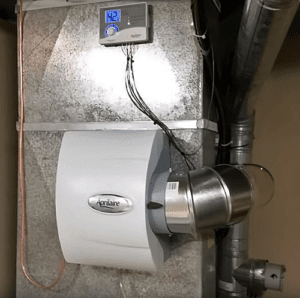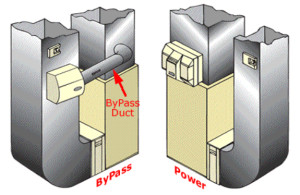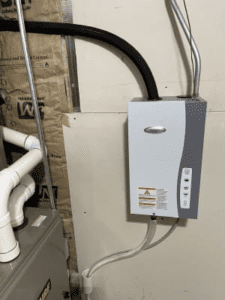Bypass Humidifier

A bypass humidifier is typically the most cost-effective route for whole home humidification as there are less internal components within the system. A bypass humidifier is installed by mounting the humidifier onto the return side of the ductwork in most cases (if the return ductwork is less accessible, it is feasible to mount the system on the supply side). The humidifier then has a 6-inch ductwork run that gets piped into the supply side of the ductwork.
The humidifier uses the heat and the blower from the furnace to push air across a humidifier media pad in order to evaporate the water and send it throughout the house. The humidifier will also be wired into a control, this control is typically a humidistat that is also mounted on the ductwork but depending on the circumstances can also be wired to the thermostat. Any excess water that makes it through the media pad will then either drain through the system’s condensate drain, or a standalone drain line.
Powered Humidifier

A powered humidifier, like a bypass humidifier, gets mounted to the ductwork. The difference in these two is that a powered humidifier has its own internal fan and generally gets mounted to the supply ductwork. The powered humidifier can be much more efficient, as it doesn’t need the system to be on while it’s running.
The powered humidifier can push air across the media pad and into the ductwork on its own causing the home to reach and maintain the desired humidity level much quicker than the bypass would.
The primary installation is similar in the two, however there are some key differences. For correct installation of the powered humidifier, normally there needs to be a power source of 120 volts to the system to power the internal fan. Depending on the circumstances, this could mean wiring in a new circuit to accommodate the electrical usage. Similarly, a powered humidifier also gets wired into either a humidistat and/or a thermostat with humidity control.
Steam Humidifier

A steam humidifier is by far the most efficient approach to whole home humidification. A steam humidifier is unique to the other types of whole home humidifiers as it in essence is a small electric boiler. The steam humidifier heats up a small tank or reservoir of water with a few electric probes.
The probes heat the water inside the tank until the water becomes steam, and at that point the steam will be introduced throughout the ductwork and eventually the entire home. Another unique feature of the steam humidifier is that it doesn’t have to be mounted to the duct work, instead it can also be mounted to a nearby wall. The steam is introduced through a ¾ inch steam line that is piped into the supply plenum.
The steam humidifier does require quite a bit more power than the other two whole home humidifier types. This is due to the heating elements inside of the system, typically the power needed is a 240-volt 20-amp circuit. Given the need for more electrical output, this system is recommended to only be installed by a trained professional. This, like the other humidifiers, can be programmed into a thermostat with humidity control, or a standalone humidistat.
Conclusion
Whether you’re looking for just supplemental humidification for comfort during the dry winters, or you’re trying to solve a recurring problem that may be caused by lack of humidity, a whole home humidifier is a great avenue to meet your desired goals. If you’re unsure which whole house humidifier is right for you, give Quality Comfort Home Services a call and we’d be happy to have one of our experts come out to discuss your needs and provide you with a free estimate.



